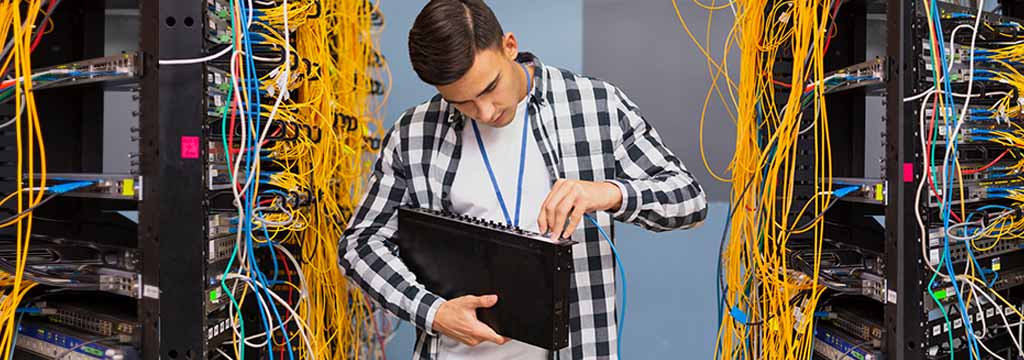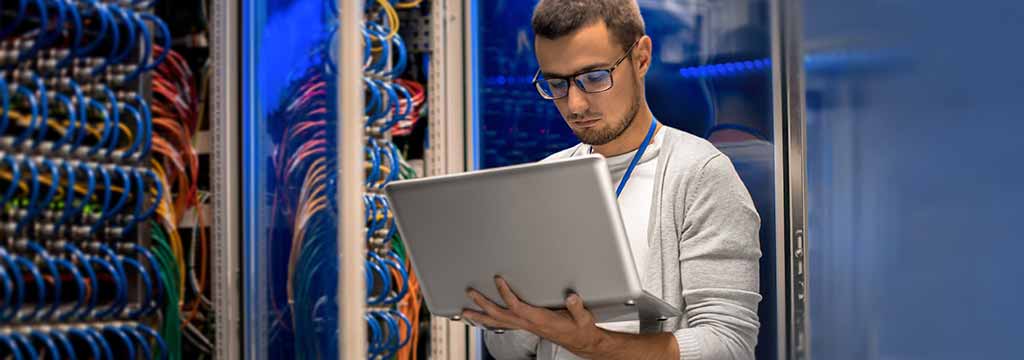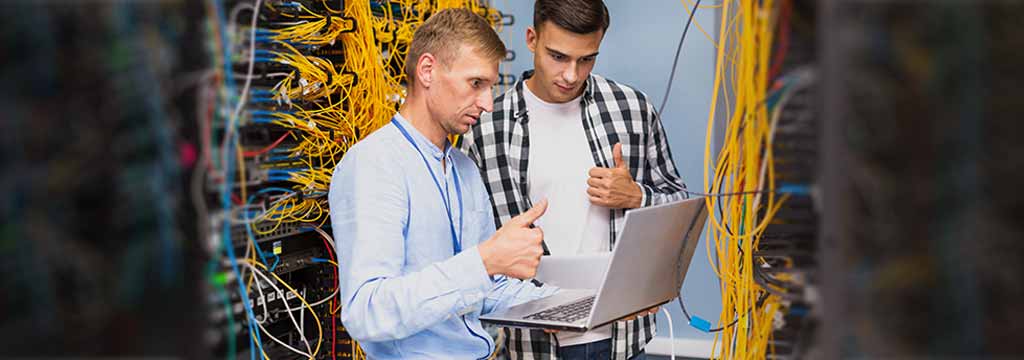The IT helpdesk has become essential to any organisation’s IT infrastructure. As technology evolves and interrupts daily operations, businesses and institutions rely on IT helpdesks to quickly and efficiently solve technical problems. This blog will discuss what an IT helpdesk is, its types, key features, and the importance of having one in place.
- What does an IT Helpdesk include? (The role and key responsibilities)
- What are the types of IT helpdesks?
- What are the key features of an IT help desk?
- What is the importance of an IT helpdesk?
- Skills and qualities of an IT help desk agent
- Future trends and predictions for IT help desks
- IT Help desk for any enterprise
What does an IT Helpdesk include? (The role and key responsibilities)
An IT help desk is a centralised resource responsible for providing technical support and assistance to end-users within an organisation. It serves as the primary point of contact for employees or customers experiencing IT-related issues, such as hardware, software, network, or other technical problems.
The IT help desk ensures that technical issues are resolved quickly and efficiently, minimising downtime and letting users return to tasks as soon as possible.
The help desk’s primary objective is to resolve technical issues swiftly and effectively, minimising downtime and letting users resume their tasks as quickly as possible.
Let’s delve into the core components and the key responsibilities of an IT help desk that make up this essential support system:

Technical Operations of an IT Help Desk
System Maintenance
- Troubleshooting technical issues:
Supervising technical troubleshooting is the core of an IT helpdesk’s primary responsibilities. They should be able to diagnose and resolve everything from failed software, connectivity, or hardware issues efficiently. This brings together technical ability, problem-solving prowess, and the skill to break down complex solutions into simple steps that end-users can understand well. - Hardware support and maintenance:
The IT helpdesk provides core support for the organisations’ hardware devices, from desktop computers to printers, networking equipment, and other hardware. This includes hardware fault finding, routine maintenance tasks such as updates and upgrades and liaising with suppliers for necessary repairs or replacements. The helpdesk makes the organisation’s IT infrastructure more productive and reliable through the assistance of hardware devices in their proper functioning.
System Management
- Software installation and configuration:
Often, IT personnel act as administrators for the installation and configuration of software applications across the organisation. This consists of confirming that software is deployed correctly and licences are adequately handled and configured correctly in alignment with organisational requirements. Furthermore, the service delivery team could advise using specific software tools to achieve high productivity and efficiency. - Incident management and ticketing:
Incident management and ticketing are vital parts of the IT helpdesk’s work. When users must report technical problems and require help, they usually submit requests like help desk tickets registered and monitored by the support team. The tickets will dictate the prioritisation and the handling of the support requests, and thus, issues will be managed based on the urgency and importance of the business’s running. Effective incident management procedures provide ways to maintain customer support workflows and decrease service downtime. - Network support:
They are also responsible for ensuring network connectivity and assisting users with network-related issues, such as Wi-Fi connectivity, VPN access, or email configuration. - Knowledge base management:
IT helpdesks generally generate a thorough knowledge base to promote more effective problem-solving processes and give end users the ability to find answers themselves. This repository includes articles, FAQs, troubleshooting, and other instructions that might come in handy when faced with common issues. By constantly improving the knowledge base, the helpdesk increases its skills to provide quick and quality user support.
Customer service responsibilities
- Responding to support requests:
Help desk agents field user support requests through phone calls, emails, chat, or other channels. They gather necessary information, assess the issue, and provide assistance or escalate it to a higher level of support. - User support and guidance:
The IT helpdesk addresses technical issues and provides user support and solutions. Thus, specific duties include assisting users with software applications, explaining IT policies and procedures, and answering any questions and concerns regarding technology usage. The help desk represents the single interface for users to get assistance in using technology resources to support the organisational efforts as expected. - Communication and customer service:
Clear and effective communication is crucial to the success of an IT help desk. Help desk personnel must communicate technical information clearly and understandably to end-users with varying levels of technical expertise. Additionally, providing excellent customer service is essential for promoting positive relationships with end-users and ensuring high satisfaction with IT support services. - User account management:
Help desk agents manage user accounts, including setting up new accounts, resetting passwords, and assisting with access permissions. - Continuous improvement:
The IT help desk is committed to continuous improvement and strives to enhance the quality and efficiency of its support services. This may involve analysing support metrics and feedback from end-users to identify areas for improvement, implementing new tools or processes to streamline support workflows, and investing in ongoing training and development for help desk staff to stay abreast of the latest technologies and best practices.

Skills and qualities of an IT help desk agent
An effective IT help desk agent should possess a range of skills and qualities, including:
- Technical expertise:
A strong understanding of various IT systems, hardware, software, and networks is essential for diagnosing and resolving technical issues. - Problem-solving skills:
Help desk agents must be able to think critically and apply logical reasoning to troubleshoot and resolve issues. - Communication skills:
Help desk agents must communicate effectively with end-users, explaining technical concepts clearly and concisely to make it easy for non-technical users to understand. - Customer service skills:
Providing exceptional customer service and professionalism is crucial for ensuring user satisfaction and building trust. - Patience and empathy:
Help desk agents often encounter frustrated users with technical issues. Patience and empathy are essential for understanding their concerns and providing adequate assistance.
What are the types of IT helpdesks?
There are several types of IT helpdesks, each designed to cater to different organisational needs:
- Internal IT helpdesk:
This helpdesk type is dedicated to supporting an organisation’s internal staff. The organisation’s IT department usually handles employee-specific issues, such as computer troubleshooting, software installation, and network connectivity. - External IT helpdesk:
An external help desk supports an organisation’s customers or clients. This can involve troubleshooting product-related issues, answering technical questions, or assisting with software and hardware installations. - Outsourced IT help desk:
Some organisations choose to outsource their IT helpdesk services to third-party providers. These providers specialise in handling IT support tasks and offer various services, from basic troubleshooting to advanced technical assistance. - Virtual IT helpdesk:
Virtual helpdesks use remote support tools and technologies to assist in a remote location. This approach allows organisations to access IT support services from a global pool of experts and can be a cost-effective option compared to maintaining an in-house helpdesk team.
What are the key features of an IT help desk?
An effective IT helpdesk should possess the following features:
- Ticketing system:
A ticketing system is crucial for tracking, prioritising, and resolving IT issues. It enables help desk agents to efficiently manage support requests and ensure that they resolve each on time. - Knowledge base:
A comprehensive knowledge base empowers help desk agents and end-users to quickly find answers to common IT issues. This can result in faster resolution times and fewer support tickets. - Remote support:
Providing remote support allows IT helpdesk agents to troubleshoot and resolve issues without being physically present at the user’s location. This can save time and resources and improve response times. - Automation:
Automating routine tasks, such as ticket routing, escalations, and notifications, can improve the helpdesk’s efficiency and ensure that IT helpdesks can handle requests promptly. - Reporting and analytics:
Monitoring helpdesk performance through reporting and analytics is essential for identifying areas of improvement, measuring the effectiveness of support strategies, and optimising the helpdesk’s overall performance.
You may also be interested in IT Support vs Data Analyst
What is the importance of an IT helpdesk?
The IT helpdesk plays a crucial role in maintaining the smooth operation of an organisation’s IT infrastructure.
Some of the key benefits include:
- Improved productivity:
Helpdesks minimise downtime and enable users to return to tasks quickly, increasing productivity. - Enhanced customer satisfaction:
A responsive and knowledgeable helpdesk can efficiently improve customer satisfaction by addressing their technical concerns. - Proactive IT management:
Help desks can identify recurring issues and trends, allowing organisations to address underlying problems proactively and prevent future disruptions.

Skills and qualities of an IT help desk agent
An effective IT help desk agent should possess a range of skills and qualities, including:
- Technical expertise:
A strong understanding of various IT systems, hardware, software, and networks is essential for diagnosing and resolving technical issues. - Problem-solving skills:
Help desk agents must be able to think critically and apply logical reasoning to troubleshoot and resolve issues. - Communication skills:
Help desk agents must communicate effectively with end-users, explaining technical concepts clearly and concisely to make it easy for non-technical users to understand. - Customer service skills: Providing exceptional customer service and professionalism is crucial for ensuring user satisfaction and building trust.
- Patience and empathy: Help desk agents often encounter frustrated users with technical issues. Patience and empathy are essential for understanding their concerns and providing adequate assistance.
Future trends and predictions for IT help desks
In the fast-evolving world of information technology (IT), it’s not enough to be abreast of the current technologies. Business organisations must leverage the most recent technologies. With the future on its way, the landscape of IT Help Desks will undergo some substantial changes. With artificial intelligence (AI) being used for solving users’ problems as well as providing customised user experiences, this is the time to discover what is driving the IT Help Desks towards the future:
Automation and Integration
- Artificial intelligence and chatbots:
Gone are the days of long wait times and repetitive troubleshooting. The future of IT Help Desks lies in the seamless integration of Artificial Intelligence and Chatbots. These intelligent systems will handle routine queries and learn from each interaction, continuously improving their problem-solving capabilities. From basic ticket resolutions to complex technical support, AI-driven Chatbots will revolutionise how users seek assistance, providing instant responses and efficient solutions. - Automation of routine tasks:
Imagine a Help Desk where mundane tasks are handled effortlessly, allowing human agents to focus on more strategic initiatives. Automation will be the cornerstone of future Help Desk operations, streamlining ticket management, software updates, and system configurations. By leveraging automation tools, IT Help Desks can boost productivity, reduce response times, and ensure consistent service delivery. - Integration with other ITSM processes:
The future Help Desk will not operate in isolation but seamlessly integrate with other IT Service Management (ITSM) processes. Whether it’s Incident Management, Change Management, or Asset Management, a cohesive ITSM framework will ensure alignment and synergy across all IT operations. This integration will foster collaboration, enhance visibility, and ultimately drive better outcomes for the organisation as a whole.
Enhanced Support Features
- Focus on remote support and mobility:
The traditional concept of IT support is undergoing a paradigm shift in an increasingly remote and mobile workforce. The future Help Desk will cater to the needs of a dispersed workforce, offering robust remote support solutions and mobile-friendly interfaces. Whether troubleshooting issues on a smartphone or assisting a remote employee halfway across the globe, Help Desks will embrace mobility to deliver timely and effective support anytime, anywhere. - Personalisation of user experiences:
The one-size-fits-all approach is becoming outdated in IT Help Desks. We will witness a shift towards personalised user experiences, which will tailor support to each user’s needs in the future. Leveraging data analytics and user profiling, Help Desks will anticipate user preferences, proactively address issues, and provide customised solutions. From personalised dashboards to targeted recommendations, users can expect a bespoke support experience that caters to their specific requirements.
You may also be interested in IT Support vs Help Desk
IT Help desk for any enterprise
The IT Help Desk is an essential pillar of any enterprise’s IT infrastructure. It delivers both elementary technical aid and basic user assistance, which comprises diagnostic skills for various aspects. The different types of IT help desks address different organisations’ IT requirements.
The main characteristics of the ticketing system, knowledge base, remote support, automation, and reporting ensure the smooth operation of desks.
Furthermore, we can say that the role of the IT help desk is undervalued because it substantially improves efficiency, increases the satisfaction of customers, and facilitates proactive IT management in companies. The main workflows of IT helpdesk professionals are technical support, problem-solving, incident management, user assistance, documentation, and continuous improvement. They can deal with different kinds of IT-related issues with the necessary competencies.
Additionally, as we watch IT help desks grow in the future, we expect developments in artificial intelligence, automation, integration with other IT service management processes, emphasis on remote support and mobility, and user experience personalisation to take place. These trends will govern IT help desks, making them more coordinated, productive, and personalised.
In summary, IT support decks are becoming more important as IT becomes more complicated. Processes are becoming smoother, user experiences are improving, and innovation is becoming the key factor of the future.

Lets Talk!
If you have additional comments or questions about this article, you can share them in this section.